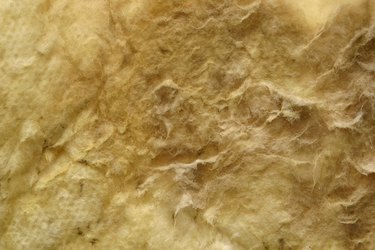
If saving money on energy is high on your "to do" list, put a review of your home's insulation materials at the top of your list. Make that climb up to the attic. Survey the shape of your insulation in the basement. Perhaps it's time to take out the old and bring in the new. If you've been using fiberglass insulation, consider wool and cellulose this time around. They are more efficient than fiberglass at sealing off air leaks and drafts that rob your home of heating and cooling, and rob your wallet, too.
Mineral Wool
Video of the Day
Mineral wool is also referred to as "rock wool." It is made of steel byproducts, such as limestone, dirt and chemicals. These materials are mixed together with chemical additives and turned into "slag." The slag is heated and spun so that it becomes fibrous. Once the slag becomes fibrous, it is transformed into insulation material. Mineral wool has an R-value (the measurement used to indicate the efficiency of insulation) of 3.1. Mineral wool insulation comes in three types: batt or roll-on insulation, loose-fill insulation and spray-on insulation.
Video of the Day
Cellulose
Cellulose insulation is made from organic materials. Newspapers and wood fibers are the major materials used to create cellulose insulation. However, because cellulose contains natural wood products, it is treated with borax-based additives to make the insulation fire retardant and to repel insects. Cellulose insulation has an R-value range of 3.6 to 3.8. There are four types of cellulose insulation -- blow-in, loose fill, spray-on and dense pack. Like wool insulation, cellulose is frequently used for residential buildings.
Similarities
Both mineral wool and cellulose have higher R-values than fiberglass, which is the common (but basic) insulation material that you often see in big pink-colored batt rolls. The R-value range for fiberglass is only 2.2 to 2.6. While mineral wool is comprised of inorganic materials and cellulose is made of organic materials, both types are more environmentally friendly choices than other types of insulation. For example, fiberglass and foam insulation are made of chemicals and synthetic non-recyclable materials. Both mineral wool insulation and cellulose insulation are recyclable.
Differences
Mineral wool is a more permanent insulation material because it does not deteriorate and is made of inorganic matter (rocks and steel byproducts). Conversely, cellulose will deteriorate over time because it is made of organic matter (paper and wood byproducts). And, because mineral wool is inorganic, it will not rot -- a major consideration if you live in a humid or rainy climate, where moisture is a concern. Mineral wool will not support or grow mold or mildew, and it is also a fire resister and a fire retardant. In the unfortunate event that a fire starts in an attic, or in between walls where mineral wool insulation is used, it will actually slow and retard the progression of the fire. One potential downside and difference is that mineral wool requires professional installation for safety reasons, while cellulose can be installed as a DIY project.
- Home Building & Remodeling.com: Mineral Wool Insulation
- North American Insulation Manufacturers Association: Rock Wool and Slag Wool Insulations for Residential and Commercial Envelope Applications
- Superseal: What Is R Value?
- Sustainable Sources: Insulation
- House Energy: Fiberglass vs. Rockwool Insulation